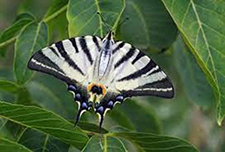Sustainability
- Home
- /
- Sustainability
- /
- Preservation of biodiversity
- /
- Monitoring of flora and fauna at KOGCF
Monitoring of flora and fauna at KOGCF GRI 304-2
The purpose of monitoring is to study the species composition and diversity, as well as determine the presence of any significant measurable changes associated with the KOGCF operations in order to adjust the Company’s activities and preserve biodiversity in this area.
Following the studies and analysis of the species abundance in a comparative aspect by years, there is no obvious negative impact from the KOGCF operations on the activity of the animals inhabiting within the field. On the contrary, as a result of the lack of agricultural activities, the general protection of the territory and the almost complete absence of a factor of disturbance by people, the conditions favourable for the life processes of the local fauna have developed at the field.
Monitoring of flora
The flora of the monitoring sites is represented by 133 species of higher plants from 31 bloodlines and 95 genera, which is 35.9% of the flora recorded for the entire territory of the KOGCF SPZ. The most common bloodlines are as follows: Asteraceae, Poaceae, Brassicaceae and Fabaceae. The most of the genera are noted in the same bloodlines. The analysis of the life forms of species showed that perennial grasses are predominant — 82 species (62.6%).
The five species listed in the Red Book of the Republic of Qazaqstan and endangered species were recorded in the research area:
Carnation andrzejowskianus (Dianthus andrzejowski), Schrenck’s tulip (Tulipa shrenkii), Woodland tulip (Tulipa biebersteiniana), Spring adonis (Adonis vernalis) and Fischer’s star of Bethlehem (Ornithogalum fischeranum). Of these, three Red Book Species make up a large abundance: Bieberstein’s Tulip (Tulipa biebersteiniana), Schrenk’s Tulip (Tulipa shrenkii), Fischer’s Bird’s-eye (Ornithogalum fischerianum).
The most of the Karachaganak field area is occupied by anthropogenic modifications of vegetation, which, to varying degrees, have lost their ecological and resource potential and biological diversity, compared to the background. The most disturbed communities are found in the area of the field infrastructure facilities and along the outskirts of roads. The anthropogenic modifications of communities are diagnosed by the presence of a significant abundance of wormwood species (Artemisia austriaca, A. lerchiana), as well as weed species such as marsupial and sandy stags (Ceratocarpus utriculosus, Allisum desertorum, Tanacetum millifolium). The negative impacts on vegetation on most part of the research area are expressed in mechanical damage to plants by poaching, passing cars, construction and other activities. Due to the passage of time, on most of the research areas, fallows, there is a gradual restoration of the damaged vegetation. A comparison of the research results of 2013,2016, 2019 and 2022 shows that where the work is no longer underway, there is a natural restoration of vegetation.
In general, the state of vegetation at the Karachaganak field can be described as satisfactory. There are no irreversible violations in the vegetation cover associated with the activities of the KPO company. Last vegetation monitoring studies were carried out in 2022.
Monitoring of fauna
The KOGCF faunal complex is a west steppe zoo-geographic site and appears to be primarily steppe in nature.
According to the literary sources, potential diversity of animals in the area of the KOGCF accounts to some 122 species of terrestrial vertebrates, including amphibians — 8, reptiles — 13, mammals — 56 and more than 200 species of birds.
As per the Biodiversity Action Plan the next stage of fauna monitoring in the Karachaganak field was carried out during spring and autumn of 2021. The population of amphibians and reptiles, taking into account seasonal changes in activity, remains at a stable level, and no changes in the species composition were noted.
The comparison of bird records demonstrated that the species composition of birds and the density of their distribution in similar biotopes in the corresponding seasons of the year do not differ significantly. The noticeable changes in the species composition of mammals, the abundance and ratio of species that included in the faunal community were not found.
The current state of the fauna in the territory under consideration is assessed as satisfactory (the change in the ratio of trophic groups of the zoocenosis is expressed in a decrease in zoophages or saprophages by 5%; the anthropogenic impact is fixed at the lower level of ecosystem stability).
The analysis of the abundance and level of faunal form species diversity of terrestrial vertebrates did not identify any noticeable negative impact from the KOGCF production facilities on the faunal complex. The business activities under normal operation at the current stage of the KOGCF operation (pollutant emissions) has an insignificant impact on animal populations being present in the region under consideration, with the exception of the area that is located directly near the production facilities. The production facilities’ operation is a factor of concern for most animals. At the same time, the territories of the facilities themselves are not lifeless. At the field itself, the production associated with the hydrocarbon extraction consists of point and linear facilities distributed over a large area, between which the islands acceptable for the fauna to inhabit are preserved.
At present, the conditions have been created for a number of signs similar to those reserve within the KOGCF and adjacent lands: there is no cattle grazing, haymaking and hunting, vehicle traffic is regulated, and there are no villages of permanent residence of people. The significant area covering various biotopes is under departmental protection.
Recent fauna monitoring studies were carried out in 2022.
Monitoring of ichthyofauna
The Ichthyofauna monitoring was performed for the first time in 2018.
According to the hydro biological studies data, the species richness of ichthyofauna in the area being studied, includes some 10 species of fishes representing 3 bloodlines that relate to 3 orders. Most common species include: crucian carp, roach and perch. All the registered species are well-known and common to the internal Qazaqstan waters (Qazaqstan Fishes, 1987-89).
The analysis of the biological parameters and composition of fish population indirectly indicates that they are in satisfactory condition.
The entomofauna monitoring was performed for the first time in 2020.
During the entomofauna survey held, 349 species or subspecies of insects and spiders related to 2 classes, 14 orders, 103 bloodlines and 290 genera were revealed on 20 monitoring sites of the KOGCF.
Species diversity of entomofauna is given in the diagram below.
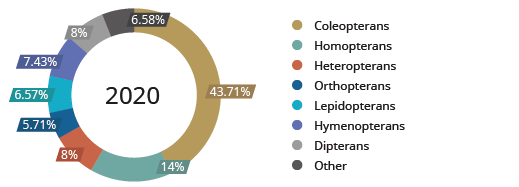
Three (3) species of insects listed in the Red Book of the Republic of Qazaqstan (dated 2006) were revealed within the KOGCF.
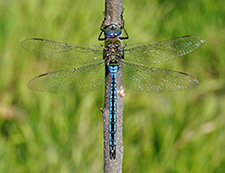 | 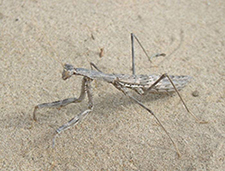 | 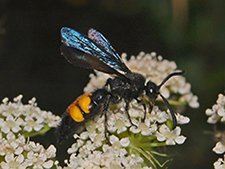 |
| Emperor dragonfly (Anax imperator Leach) | Bolivaria brachyptera Pall. | Scoliid wasps (Scolia hirta) |
One of the species not listed in the Qazaqstan Red Data Book, — Iphiclides podalirius L. butterfly is characterised as depopulating species.
